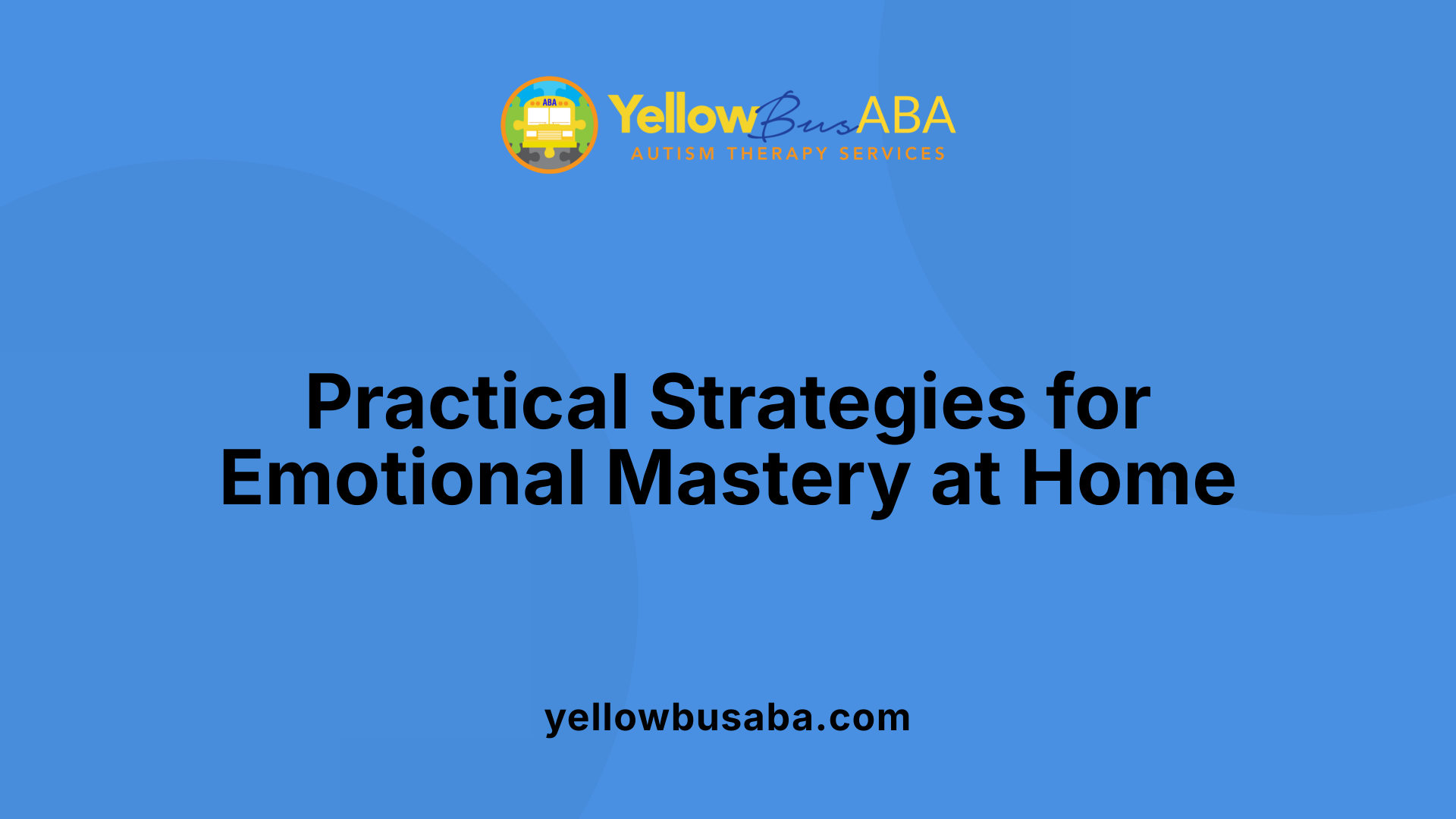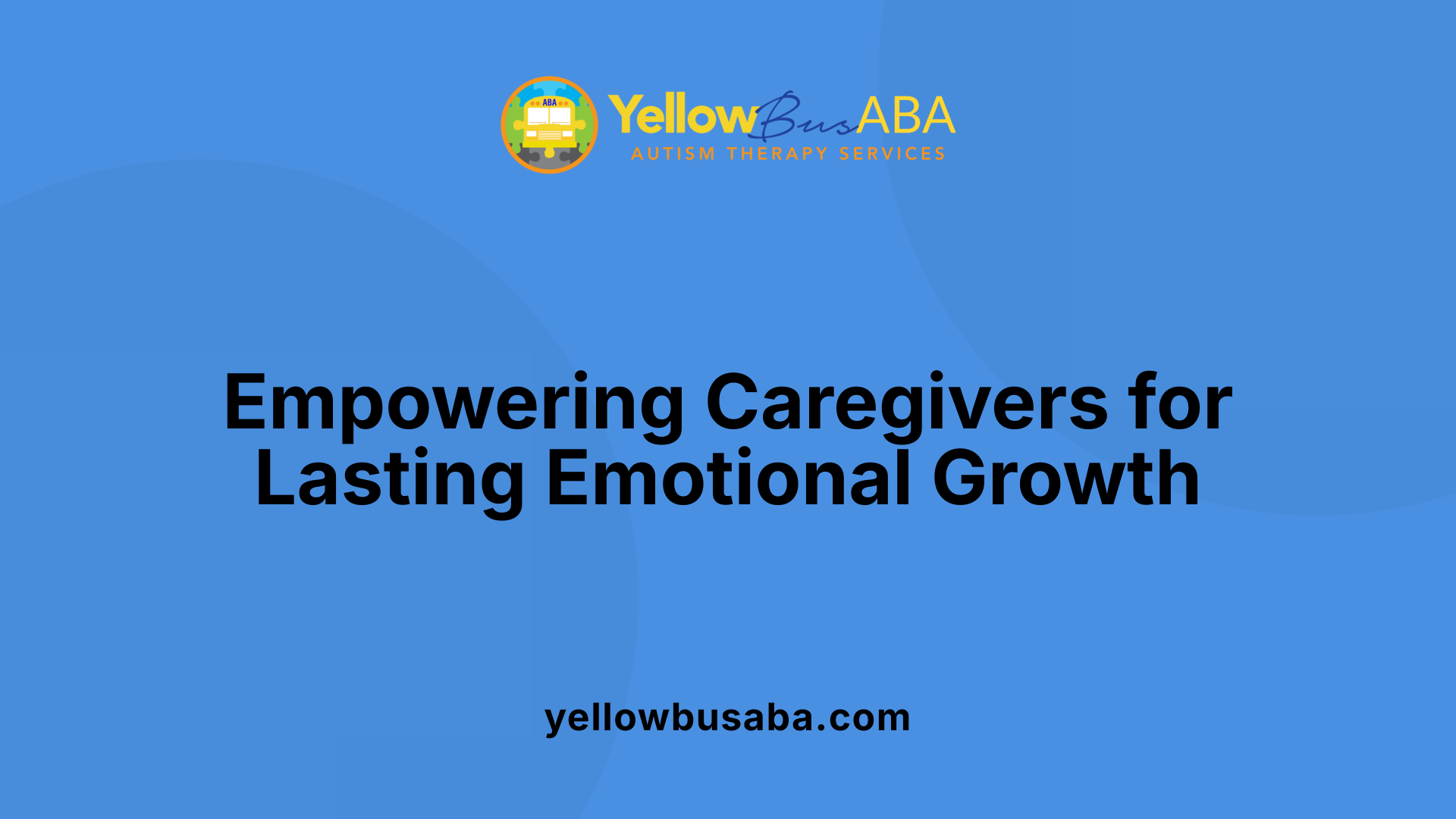How At-Home ABA Therapy Helps with Emotional Regulation
August 25, 2025
Empowering Emotional Growth at Home

Understanding the Impact of At-Home ABA Therapy on Emotional Regulation
At-home Applied Behavior Analysis (ABA) therapy has emerged as a highly effective approach for helping children with autism develop crucial emotional regulation skills. Tailored to individual needs, this therapy not only fosters behavioral growth but directly influences emotional awareness, control, and resilience, enabling children to navigate their feelings in a supportive environment.
Core Principles of ABA in Emotional Regulation

How does ABA therapy help children recognize, understand, and respond to their feelings?
ABA therapy centers on helping children build awareness of their emotions and respond appropriately in various situations. The approach involves teaching children to recognize and label their feelings using visual aids like emotion charts or social stories. These visual supports make abstract feelings more tangible, allowing children to better understand what they are experiencing. By understanding their emotions, children can learn to manage them more effectively.
Furthermore, ABA emphasizes developing emotional responses through repeated practice and reinforcement. For example, children learn to identify triggers, such as frustration or anxiety, and respond with suitable coping strategies like asking for help or taking a deep breath. This empowering process encourages independence and emotional control, key to social success.
What techniques like labeling emotions, visual supports, and social stories are used in ABA?
Labeling emotions is fundamental in ABA, often achieved through visual supports such as emotion cards or charts that depict different feelings. These tools help children connect words with their internal experiences, laying the groundwork for emotional literacy.
Social stories serve as personalized narratives that illustrate common social and emotional situations. They guide children through understanding what to expect and how to respond appropriately, reinforcing emotional regulation.
Mirror games are other interactive techniques used to teach children about emotional expressions by mimicking facial cues, helping them understand emotions in others. These strategies collectively enhance emotional awareness and improve social interactions.
Why is positive reinforcement and structured intervention important in ABA?
Positive reinforcement is at the heart of ABA. When children demonstrate self-control, such as calming down after an outburst or using coping strategies, they receive rewards or praise. This encourages the repetition of calm behaviors and embeds these skills into their routine.
Structured interventions ensure that learning is consistent and targeted. Sessions are carefully planned with clear goals, gradually increasing in complexity, enabling children to develop their emotional regulation skills step-by-step.
In summary, ABA integrates multiple techniques—labeling emotions, visual supports, social stories, and reinforcement—to teach children vital emotional skills. These methods foster a supportive environment where children can learn to manage their feelings effectively, leading to improved social and behavioral outcomes.
| Technique | Description | Purpose |
|---|---|---|
| Labeling Emotions | Using emotion cards and charts | Builds emotional literacy |
| Visual Supports | Visual schedules and cues | Enhances understanding of routines and feelings |
| Social Stories | Personalized stories for social situations | Guides appropriate responses |
| Mirror Games | Mimicking facial expressions | Teaches emotion recognition |
| Positive Reinforcement | Praise and rewards | Encourages desirable behaviors |
This comprehensive approach nurtures emotional resilience, helping children become more adaptable and confident in navigating their social worlds.
Techniques and Strategies in At-Home Settings

What techniques and strategies are used in at-home ABA therapy for emotional regulation?
When implementing ABA therapy at home, caregivers and therapists utilize a variety of practical strategies to help children develop emotional regulation skills. A primary method involves the use of visual supports such as emotion charts, cue cards, and emotion thermometers. These tools make it easier for children to recognize, label, and understand their feelings.
Modeling behavior plays a vital role. Caregivers are encouraged to demonstrate how to label emotions verbally, through social stories, or with physical cues. Discrete trial teaching is also employed, where specific teaching moments focus on identifying and responding to emotions in a structured way. This repetition helps children internalize emotional cues and responses.
Teaching prerequisite skills is fundamental. These include communication abilities, impulse control, and self-awareness. For example, caregivers might model how to ask for help or take deep breaths when upset. Reinforcement strategies are integral; positive feedback and rewards encourage the child to practice self-regulation behaviors.
Coping strategies are taught explicitly. Children learn to ask for a break, use stress balls or fidget tools, and employ calming techniques like deep breathing or counting. Recognizing what triggers upset or anxiety—often tracked through behavior logs—helps in developing proactive plans.
The generalization of skills across different environments—such as from therapy sessions to home settings—is essential. Consistent reinforcement and practice across contexts help children maintain and adapt their emotional regulation skills.
These strategies are tailored to meet each child’s needs, ensuring that they build resilience and learn to manage their emotions effectively at home and beyond.
Techniques and Strategies Used in At-Home ABA Therapy
| Technique | Description | Benefits |
|---|---|---|
| Visual Supports | Emotion charts, cue cards, thermometers | Enhances recognition and labeling of feelings |
| Modeling | Demonstrating emotional labels and responses | Encourages imitation and understanding |
| Discrete Trial Teaching | Structured teaching focusing on specific emotional skills | Reinforces learning through repetition |
| Teaching Prerequisites | Communication, impulse control, self-awareness training | Builds foundational skills for regulation |
| Reinforcement & Feedback | Positive reinforcement for desired behaviors | Motivates continued practice |
| Coping Strategies | Asking for help, breaks, deep breaths, stress tools | Provides tools for self-calming |
| Trigger Identification | Behavior logs to identify emotional triggers | Helps in proactive planning |
| Skill Generalization | Practice across home, school, community environments | Ensures skills are applied in various contexts |
This approach ensures a comprehensive, personalized, and consistent methodology for teaching emotional regulation to children with autism and other developmental conditions.
Empowering Children Through Communication and Social Skills
How does at-home ABA therapy support emotional regulation in children with autism?
At-home ABA therapy plays a vital role in helping children with autism manage their emotions effectively. It provides a personalized approach, teaching children to recognize, understand, and express their feelings in appropriate ways. Therapists use customized interventions tailored to each child's unique needs, focusing on building emotional awareness and coping strategies.
One common technique involves using positive reinforcement to encourage desired behaviors, such as calmness or patience. The A-B-Cs model—antecedent, behavior, consequence—is employed to help children understand the triggers of their emotional responses and learn healthier reactions. This structured framework helps children identify what leads to emotional outbursts or frustration and develop strategies to handle those situations better.
In addition, visual supports like emotion cards or charts can aid children in labeling their feelings. These tools make abstract concepts more concrete, helping children communicate their emotions clearly. Reinforcing these skills in everyday environments, including home, builds consistency and confidence.
Research indicates that at-home ABA therapies significantly improve emotional regulation, social skills, and overall independence. They foster resilience by teaching children adaptive ways to cope with stress and frustration, thereby reducing challenging behaviors and promoting emotional growth.
Ultimately, at-home ABA creates a supportive setting where children can practice new skills, gain self-control, and develop greater emotional resilience, which translates to better functioning across various aspects of their lives.
Building Emotional Awareness and Coping Skills
How does ABA therapy teach children to identify and label their emotions?
ABA therapy helps children recognize their feelings through visual supports like emotion charts, thermometers, and cue cards. These tools make it easier for children to understand and communicate their emotions. Therapists often use social stories and modeling to demonstrate emotional vocabulary, helping children learn to label feelings such as happy, sad, angry, or frustrated. Through repetitive practice and reinforcement, children become more adept at identifying their emotional states across different situations.
What coping strategies are introduced in ABA therapy, such as asking for help or using stress tools?
ABA therapy teaches practical coping skills that children can use daily. These strategies include requesting assistance when overwhelmed, taking deep breaths to calm down, and using stress balls or fidget toys to manage anxiety. Visual cues like break cards or visual schedules help children anticipate upcoming activities and reduce frustration. Teaching these techniques involves guided practice, role-playing, and positive reinforcement to reinforce their use. Over time, children learn to employ these strategies independently, contributing to better emotional regulation.
How does reinforcement encourage emotional regulation behaviors?
Reinforcement plays a vital role in shaping behavior in ABA therapy. When children successfully use coping strategies or demonstrate emotional regulation, caregivers and therapists provide praise, rewards, or tokens. This positive reinforcement strengthens the connection between the behavior and positive outcomes, motivating children to continue practicing self-control. Reinforcement also encourages the development of healthier responses to feelings, reduces problematic behaviors like meltdowns, and promotes overall emotional resilience.
How are these techniques used at home to support emotional regulation?
At home, caregivers implement similar strategies to those used in therapy sessions. They use visual supports such as emotion charts to help children identify feelings and model verbal labeling and coping behaviors. Creating a predictable routine with visual schedules and offering choices helps children feel more in control, reducing emotional outbursts. Caregivers also reinforce positive behaviors by praising efforts and success, encouraging children to use learned coping skills like asking for help or taking deep breaths during challenging moments. Consistency between therapy and home environments enhances skill generalization.
Overview of at-home ABA strategies for emotional regulation
| Technique | Description | Benefits |
|---|---|---|
| Visual supports | Emotion charts, cue cards | Improves emotion recognition |
| Modeling and social stories | Demonstrating appropriate responses | Reinforces understanding |
| Teaching coping strategies | Asking for help, deep breathing | Builds resilience |
| Reinforcement | Praise and rewards | Motivates continued effort |
| Behavioral logs | Tracking emotional triggers | Identifies patterns for intervention |
| Skill generalization | Practicing across settings | Ensures consistency and independence |
These combined methods foster a supportive environment where children can better understand and manage their emotions. When consistent, they help children develop skills that lead to improved social interactions and emotional well-being, both at home and in broader settings.
Generalization and Real-World Application of Skills
 Ensuring that children transfer their newly learned emotional regulation skills across different environments like home, school, and community is crucial for their overall development and success. ABA therapy emphasizes the importance of consistency among caregivers and family members, which helps reinforce the skills acquired during therapy sessions.
Ensuring that children transfer their newly learned emotional regulation skills across different environments like home, school, and community is crucial for their overall development and success. ABA therapy emphasizes the importance of consistency among caregivers and family members, which helps reinforce the skills acquired during therapy sessions.
In the home setting, parents and siblings actively participate by modeling emotional vocabulary, using visual cues, and maintaining routines that support emotional understanding. For example, they might use emotion charts to help the child label feelings or implement visual schedule tools that prepare the child for upcoming changes, reducing anxiety and emotional outbursts.
Across various settings, the consistent use of reinforcement strategies ensures that children get positive feedback when demonstrating adaptive emotional responses. This reinforcement helps solidify the connection between appropriate behaviors and positive outcomes, encouraging continuous practice.
To highlight the impact, here are some notable benefits of applying ABA techniques in home environments:
| Benefit | Description | Additional Notes |
|---|---|---|
| Improved Emotional Recognition | Children learn to identify and label their feelings more accurately. | Visual supports and social stories are effective tools. |
| Reduction of Challenging Behaviors | Outbursts and aggression decrease as children develop better self-control. | Reinforcement of calm behaviors encourages repetition. |
| Enhanced Communication Skills | Ability to express needs using words, signs, or devices improves. | Practice sessions include role-playing and modeling. |
| Increased Consistency | A structured approach across environments fosters stability. | Parental involvement is key to success. |
| Promotion of Emotional Flexibility | Children become adaptable, adjusting their responses to different situations. | Visual aids like timers and schedules assist. |
By integrating these strategies at home, children can generalize emotional regulation skills across settings, leading to better social functioning and independence.
The collaborative effort among caregivers—modeling emotional labels, providing visual cues, and celebrating small successes—creates a supportive environment that encourages the child's growth. Consistency and reinforcement across settings develop resilience and confidence, empowering children to handle emotions more effectively.
How do I promote consistency among caregivers and family members?
Consistency begins with clear communication and shared understanding of therapeutic goals. Family members should learn and regularly practice strategies such as using visual supports, prompt fading techniques, and reinforcement schedules. Regular training sessions or consultations with ABA professionals can help caregivers stay aligned. Establishing routines and cues that are used uniformly across environments boosts predictability, reducing anxiety and aiding emotional regulation.
What are the benefits of at-home ABA therapy in improving emotional regulation skills?
At-home ABA therapy allows for personalized interventions tailored to each child's unique needs, providing a comfortable environment for practicing emotional recognition and coping strategies. It helps children learn to manage stress, avoid meltdowns, and express their feelings effectively. The therapy fosters better communication, social interactions, and resilience, ultimately leading to increased independence.
How does at-home ABA therapy support emotional regulation in children with autism?
Through individualized, structured interventions, at-home ABA helps children recognize, understand, and express emotions appropriate to the context. Techniques like positive reinforcement, visual aids, and routines teach children coping mechanisms such as asking for help or taking deep breaths. Over time, these skills reduce problematic behaviors and increase emotional resilience, supporting better social integration.
In summary, the transfer of skills from therapy to daily life depends on consistent practices and active caregiver involvement. When well-implemented, ABA therapy significantly enhances emotional regulation, empowering children with autism to navigate their environment with greater confidence and independence.
Long-term Benefits and Personalized Outcomes

What are the outcomes of at-home ABA therapy related to emotional control and regulation?
ABA therapy, particularly when conducted at home, has demonstrated significant improvements in emotional regulation for children with autism spectrum disorder (ASD). The therapy focuses on teaching children coping strategies, such as asking for help, requesting breaks, using deep breathing, and employing stress-relief tools like fidgets or sensory bottles. These skills enable children to better understand and manage their emotional responses.
One notable benefit of ABA therapy is its role in enhancing communication skills, allowing children to express their needs verbally, through signs, or using assistive technology. This improved ability to communicate reduces frustration and emotional outbursts, contributing to greater calmness and emotional stability.
Moreover, ABA promotes emotional awareness by teaching children to identify and label their feelings. Visual supports, social stories, and modeling activities help in recognizing triggers of emotional responses. As children learn to respond in healthier ways—such as taking deep breaths or using calming tools—they develop resilience and self-esteem.
The structured environment of ABA helps in breaking down stressful or overwhelming situations into manageable steps, teaching children how to cope effectively. Reinforcement techniques positively reinforce appropriate emotional responses and self-regulation behaviors. These strategies are reinforced consistently across different settings, including home, school, and community, fostering generalization of skills.
Long-term outcomes of effective ABA therapy extend beyond immediate emotional control. Children often show improvements in daily living activities, social interactions, and overall independence. They tend to become more adaptable to changes in routines, which further enhances emotional flexibility.
The therapy also addresses repetitive behaviors—such as hand-flapping or repetitive phrases—by reinforcing alternative, functional behaviors. Skills like sharing, turn-taking, and understanding social cues are developed through role-playing and modeling, leading to better social relationships.
Targeted activities in ABA also support motor skill development, which can contribute to participating in everyday tasks with less emotional distress. Addressing emotional outbursts and anxiety through proactive strategies—like visual schedules and choice-making—encourages calm, measured responses.
A significant factor influencing positive outcomes is the early initiation of therapy. Early intervention maximizes the ability to build foundational emotional and social skills before behaviors become more ingrained. The intensity and consistency of therapy sessions are also crucial for durable results.
Personalized treatment plans designed within ABA account for each child's unique needs and challenges. By tailoring interventions, therapists can more effectively target specific emotional regulation difficulties, resulting in better long-term success.
Parents’ involvement plays a vital role in reinforcing emotional regulation strategies outside of structured therapy sessions. Supporting their child's development at home through modeling, visual cues, and celebrating small successes encourages ongoing progress.
How does the importance of early intervention, therapy intensity, and individualized treatment plans impact these outcomes?
Early intervention allows children to develop critical emotional and social skills during sensitive developmental periods, leading to more substantial and lasting improvements. The earlier therapy begins, the more effectively children can learn adaptive coping mechanisms and communication strategies.
Therapy intensity refers to the frequency and consistency of ABA sessions. Higher intensity often correlates with faster skill acquisition and better maintenance of new behaviors, including emotional regulation. Regular reinforcement across different settings ensures these skills are retained and generalized.
Individualized treatment plans are essential to address the unique emotional profiles and learning styles of each child. Tailoring interventions ensures that strategies are relevant and effective, ultimately fostering better emotional control and resilience over the long term.
| Aspect | Impact on Emotional Regulation | Description |
|---|---|---|
| Early Intervention | Significant | Builds foundational skills, prevents development of maladaptive behaviors |
| Therapy Intensity | High | Ensures consistent skill reinforcement, accelerates growth |
| Individualized Plans | Crucial | Addresses specific emotional needs, enhances engagement |
This combination of early, intensive, and personalized therapy enhances the likelihood of positive long-term outcomes, leading to increased independence, improved social functioning, and overall enhanced quality of life.
The Role of Caregivers in Emotional Regulation Success

How does at-home ABA therapy support emotional regulation in children with autism?
At-home ABA therapy plays a vital role in helping children with autism gain better control over their emotional responses. It involves customized interventions designed to teach children how to recognize, understand, and express their feelings in healthy and meaningful ways.
Therapists often utilize methods like positive reinforcement and the A-B-Cs model (Antecedent-Behavior-Consequence) to promote emotional regulation. These techniques help children replace challenging behaviors with more adaptive responses, such as asking for assistance or taking calming breaks.
The therapy is tailored to each child's unique needs, focusing on developing skills like self-control, frustration tolerance, and effective social communication. Visual supports, such as emotion cards and social stories, along with proactive tools like break cards and sensory items, aid children in managing their emotions.
Research supports that consistent, structured ABA interventions can lead to significant improvements in emotional and social skills. This progress fosters increased independence and emotional resilience over time.
By creating a predictable and supportive environment at home, caregivers enable children to practice and strengthen these emotional regulation strategies continually. This ongoing reinforcement helps children generalize their skills across different settings, enhancing their overall well-being.
In essence, at-home ABA therapy empowers children with autism to better understand their emotions and respond appropriately, laying the foundation for improved social interactions and a higher quality of life.
Fostering Emotional Resilience through Structured Support
The integration of ABA therapies into the home environment offers a comprehensive pathway for children with autism to develop essential emotional regulation skills. Through personalized techniques like visual supports, modeling, and reinforcement, children learn to identify, understand, and manage their emotions effectively. The active involvement of parents and caregivers amplifies these benefits, promoting consistency and generalization across different settings. Long-term, these interventions foster greater independence, social competence, and resilience, significantly enhancing the child's overall quality of life. As research continues to affirm the effectiveness of at-home ABA therapy, it remains a cornerstone in supporting emotional growth in children with autism, equipping them with the skills necessary for a more autonomous and emotionally balanced future.
References
- When Big Feelings Show Up: How ABA Therapy Supports ...
- The Importance of ABA Therapy in Supporting Emotional Regulation
- 7 Signs & Symptoms of Autism in Kids and How ABA Therapy Can ...
- Home-Based ABA Therapy to Prepare Your Toddlers For School
- ABA Therapy for Emotional Regulation: From Meltdowns to Mastery
- Simple Evidence-based Strategies for Teaching Emotion Regulation
- When Big Feelings Show Up: How ABA Therapy Supports ...
- Navigating Emotional Outbursts with ABA Therapy Techniques
- Applied Behavior Analysis (ABA) | Autism Speaks
- Is ABA Therapy Worth It? - Behavioral Intervention For Autism


.avif)



